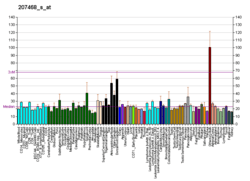SFRP5
Secreted frizzled-related protein 5 is a protein that in humans is encoded by the SFRP5 gene.[5][6]
Secreted frizzled-related protein 5 (SFRP5) is a member of the SFRP family that contains a cysteine-rich domain homologous to the putative Wnt-binding site of Frizzled proteins. SFRPs act as soluble modulators of Wnt signaling. SFRP5 and SFRP1 may be involved in determining the polarity of photoreceptor cells in the retina. SFRP5 is highly expressed in the retinal pigment epithelium, and moderately expressed in the pancreas.[6]
References
- 1 2 3 GRCh38: Ensembl release 89: ENSG00000120057 - Ensembl, May 2017
- 1 2 3 GRCm38: Ensembl release 89: ENSMUSG00000018822 - Ensembl, May 2017
- ↑ "Human PubMed Reference:".
- ↑ "Mouse PubMed Reference:".
- ↑ Melkonyan HS, Chang WC, Shapiro JP, Mahadevappa M, Fitzpatrick PA, Kiefer MC, Tomei LD, Umansky SR (Jan 1998). "SARPs: A family of secreted apoptosis-related proteins". Proc Natl Acad Sci U S A. 94 (25): 13636–41. doi:10.1073/pnas.94.25.13636. PMC 28358. PMID 9391078.
- 1 2 "Entrez Gene: SFRP5 secreted frizzled-related protein 5".
Further reading
- Veeck J, Geisler C, Noetzel E, et al. (2008). "Epigenetic inactivation of the Secreted frizzled-related protein-5 (SFRP5) gene in human breast cancer is associated with unfavorable prognosis". Carcinogenesis. 29 (5): 991–998. doi:10.1093/carcin/bgn076. PMID 18356147.
- Urakami S, Shiina H, Enokida H, et al. (2006). "Combination analysis of hypermethylated Wnt-antagonist family genes as a novel epigenetic biomarker panel for bladder cancer detection". Clin. Cancer Res. 12 (7 Pt 1): 2109–16. doi:10.1158/1078-0432.CCR-05-2468. PMID 16609023.
- Gerhard DS, Wagner L, Feingold EA, et al. (2004). "The Status, Quality, and Expansion of the NIH Full-Length cDNA Project: The Mammalian Gene Collection (MGC)". Genome Res. 14 (10B): 2121–7. doi:10.1101/gr.2596504. PMC 528928. PMID 15489334.
- Deloukas P, Earthrowl ME, Grafham DV, et al. (2004). "The DNA sequence and comparative analysis of human chromosome 10". Nature. 429 (6990): 375–81. doi:10.1038/nature02462. PMID 15164054.
- Strausberg RL, Feingold EA, Grouse LH, et al. (2003). "Generation and initial analysis of more than 15,000 full-length human and mouse cDNA sequences". Proc. Natl. Acad. Sci. U.S.A. 99 (26): 16899–903. doi:10.1073/pnas.242603899. PMC 139241. PMID 12477932.
- Chang JT, Esumi N, Moore K, et al. (1999). "Cloning and characterization of a secreted frizzled-related protein that is expressed by the retinal pigment epithelium". Hum. Mol. Genet. 8 (4): 575–83. doi:10.1093/hmg/8.4.575. PMID 10072424.
- Hu E, Zhu Y, Fredrickson T, et al. (1998). "Tissue restricted expression of two human Frzbs in preadipocytes and pancreas". Biochem. Biophys. Res. Commun. 247 (2): 287–93. doi:10.1006/bbrc.1998.8784. PMID 9642118.
- Rattner A, Hsieh JC, Smallwood PM, et al. (1997). "A family of secreted proteins contains homology to the cysteine-rich ligand-binding domain of frizzled receptors". Proc. Natl. Acad. Sci. U.S.A. 94 (7): 2859–63. doi:10.1073/pnas.94.7.2859. PMC 20287. PMID 9096311.
This article is issued from
Wikipedia.
The text is licensed under Creative Commons - Attribution - Sharealike.
Additional terms may apply for the media files.




